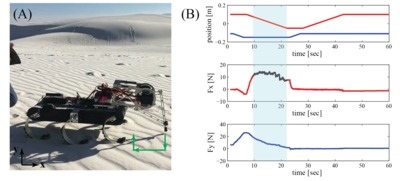
Predicting the susceptibility of soil to wind erosion is difficult because it is a multivariate function of grain size, soil moisture, compaction, and biological growth. Erosive agents like plowing and grazing also differ in mechanism from entrainment by fluid shear; it is unclear if and how erosion thresholds for each process are related. Here we demonstrate the potential to rapidly assemble empirical maps of erodibility while also examining what controls it, using a novel “plowing” test of surface-soil shear resistance (𝜏r) performed by a semi-autonomous robot. Field work at White Sands National Monument, New Mexico, United States, examined gradients in erodibility at two scales: (i) soil moisture changes from dry dune crest to wet interdune (tens of meters) and (ii) downwind-increasing dune stabilization associated with growth of plants and salt and biological crusts (kilometers). We found that soil moisture changes of a few percent corresponded to a doubling of 𝜏r, a result confirmed by laboratory experiments, and that soil crusts conferred stability that was comparable to moisture effects. We then compared different mechanisms of mechanical perturbation in a controlled laboratory setting. A new “kick-out” test determines peak shear resistance of the surface soil as a proxy for yield strength. Kick-out resistance exhibited a relation with soil moisture that was distinct from the plowing test and that was correlated with the independently measured threshold-fluid stress for wind erosion. Results show that our new method maps soil erodibility in arid environments and provides an understanding of environmental controls on variations in soil erodibility. (For more information: Kod*lab)

